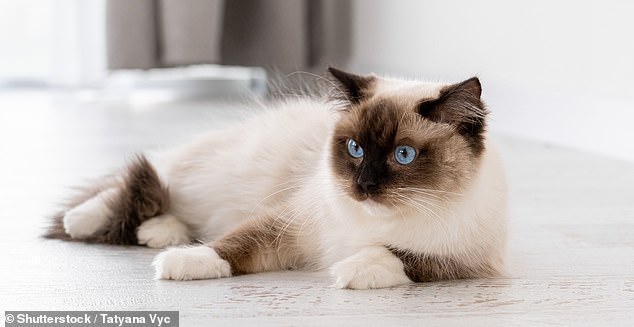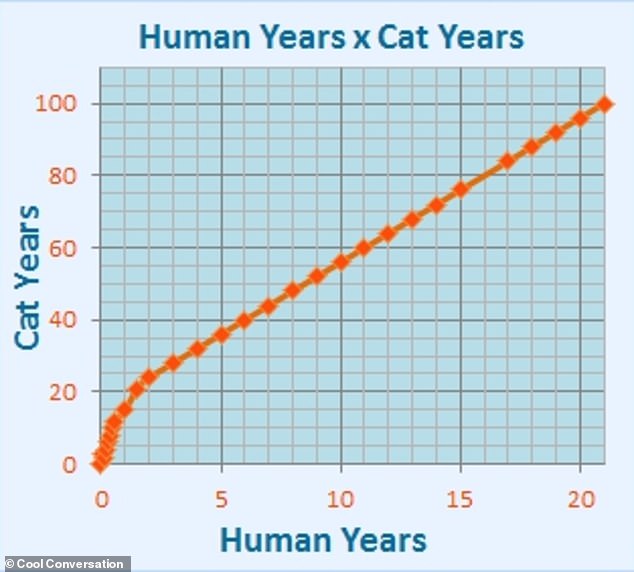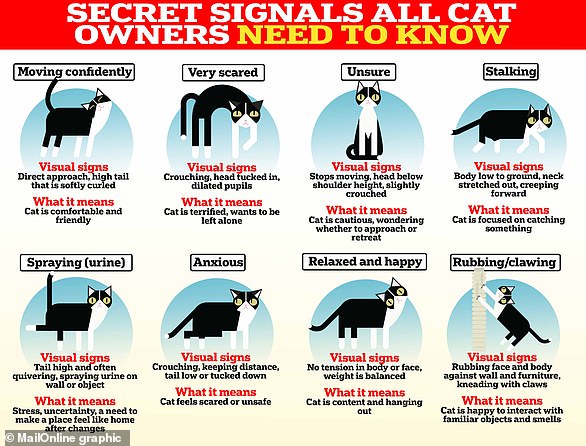How old your cat REALLY is: The biological calculator that reveals your kitty’s ‘true age’
>
People often talk about the age of their pet dog in dog years – but what about cat lovers?
In contrast to the well-known 7:1 years ratio for calculating your dog’s age, very little has been said about how to estimate the age of cats.
Some say the same rule applies to cats, but as with canine companions, the science doesn’t back this up.
Experts say this is because the cat ages at a different rate depending on the stage of life it is going through.
Early on, he ages much faster compared to humans, but this slows down as he gets older.

People often talk about the age of their pet dog in dog years – but what about cat lovers? Our feline friends age much faster than humans early on, but this stabilizes later in life
For example, when a cat is a month old, research suggests that its true age is actually closer to six months.
But after just 60 days, this jumps to the equivalent of a 4-year-old human.
This rapid aging continues month after month to 5.5 years in four months, 8.5 years in five months, and 11.5 years in six months, before slowing down so much that when the cat reaches 12 months, its actual age is only 16 years. .
Do the math and that means cats are 11.5 years old in the first six months of their lives and only 4.5 years old in the next six months.
However, there is another way to calculate a cat’s age a little differently.
The first two years are very similar – the equivalent of a 16-year-old human at 12 months and a 21-year-old at 2 years.
However, it is then suggested that after that, each additional human year is four “cat years.”
For example, at three his real age would be 25, at four he would be 29, and at five he would be 33.
“A 1-year-old cat is physiologically similar to a 16-year-old human, and a 2-year-old cat is physiologically similar to a 21-year-old person,” Cornell University College of Veterinary Medicine said.
“And every year after that, each cat year equals about four human years.”
| Human years | Real age |
|---|---|
| one month | 6 months |
| 3 months | 4 years |
| 6 months | 11.5 years |
| 1 year | 16 years old |
| 2 | 25 |
| 3 | 31 |
| 5 | 38.5 |
| 7 | 46.5 |
| 10 | 58 |
| 13 | 68.5 |
| 16 | 78 |
| 19 | 86 |
“Using this formula, a 10-year-old cat is similar in age to a 53-year-old person, a 12-year-old cat to a 61-year-old person, and a 15-year-old cat to a 73-year-old person.
The first method is a little different because it only increases by four.
Instead, she points out that a three-year-old cat is actually 31 years old, a four-year-old cat is 35 years old, and a five-year-old cat is actually 38 and a half years old in human years.
The average lifespan of a domestic cat is around 14 years, but the oldest cat ever recorded – called Creme Puff – reached an incredible 38 years.
The Texas cat was born in August 1967 and died in August 2005, according to Guinness World Records.
The fact that the two competing calculators put the beginning of a cat’s middle life at around six (41 years and 40 years, respectively) is consistent with its life expectancy.
This has increased dramatically over the past few decades, with the average lifespan of a cat being just seven years in the early 1980s, and just over nine years in 1995.
A cat’s age is generally determined by examining the condition of its teeth.

Theory: When a cat is 1 month old, research suggests that its true age is closer to 6 months

Biological calculators indicate that a three-year-old cat is actually 31 years old, a four-year-old cat is 35 years old, and a five-year-old cat is actually 38 and a half years old in human years. This graphic gives an example
In young cats, this means measuring growth, while in older cats, veterinarians check for wear and tear.
Complex charts are then deployed to convert this information into the cats’ true age.
However, there are other factors to take into consideration as well.
First, it is important to monitor cats’ physical traits rather than emotional traits because many exhibit cat-like behavior throughout their adult years.
But one of the main things to pay attention to is how your pet’s fur changes: young ones have fine, downy hair, while older cats tend to have thicker, coarser fur with gray patches within it.
Older cats may also be more bony, have extra skin hanging or protruding at the shoulders and more opaque eyes.
Of course, it’s never easy to determine with certainty, but if you want to gauge your cat’s approximate age, the calculator and table above are a good place to start – and a much more accurate method than the 7:1 rule!
(Tags for translation) Daily Mail

